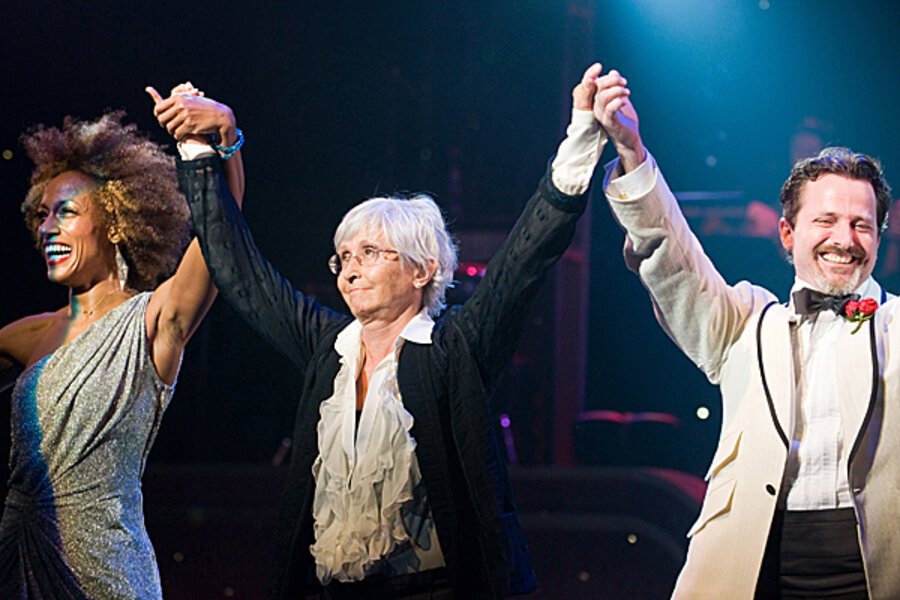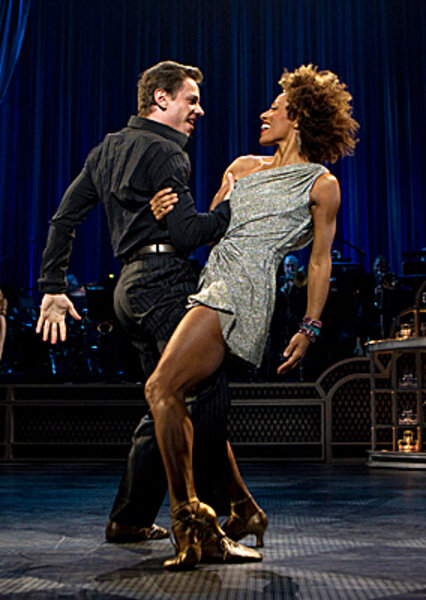Twyla Tharp takes a spin once more with Sinatra in 'Come Fly Away'
Loading...
| New York
Veteran choreographer Twyla Tharp has been making dances to the Frank Sinatra songbook for more than 30 years, so it was no surprise she turned again to Ol’ Blue Eyes for her latest foray onto Broadway. “Come Fly Away,” a wordless musical that follows four couples in and out of love, is currently playing at New York’s Marquis Theatre.
“Come Fly Away” is a joyous evening in the theater, fueled by a company of virtuoso dancers whom Tharp has prodded into delivering performances that sizzle. The action unfolds in a nightclub, with an 18-piece live orchestra, and occasionally a female vocalist, warbling along to Sinatra’s recorded voice. Although the plotlines are familiar – and inconsequential – the moves of the dancers are not. Tharp manages to roll together ballroom dance, hip-hop, modern, and ballet technique into choreography as expressive of emotions and frustrations as the whispered repartee between lovers.
“I look at it as a silent movie,” she says. Tharp first used Sinatra songs for “Once More Frank” (1976), which she performed with Mikhail Baryshnikov at an American Ballet Theatre gala. “I hoped we could get him [Sinatra] to sing. It was a fundraiser. We both thought he was terrific. If you’re going to go popular, why not go with the best?”
Her introduction to Sinatra came early, through her mother. Back in the 1950s when Twyla was 8 years old, she worked at her mother’s drive-in theater in San Bernardino, Calif. “The cars had individual speakers. During intermission my mother would pipe through music. I’m sure Sinatra was part of the mix because he was her favorite vocalist.”
“Checking on cars sneaking into the drive-in and bagging the corn,” as she describes her childhood assignment, was an unlikely beginning to a distinguished career in contemporary dance that has ranged from running her own company (1965-88) and creating 135 dances for that troupe and many others across the globe to providing dance for four films and directing on Broadway. Her most successful show, “Movin’ Out” (2002), ran for three years in New York, in addition to several national tours. The cascade of her awards has included 19 honorary degrees, a MacArthur “genius” fellowship, and the Kennedy Center Honors in 2007.
Popular dance has been a constant thread through Tharp’s choreography from the start, even though she was trained intensively in ballet as well as modern dance. Several years after “Once More Frank,” Tharp began to research historic styles. She fell in love with the pre-World War I ballroom couple Vernon and Irene Castle. Watching them on film, she remembered Sinatra’s affinity to romance and “began to listen to all the Sinatra I could get my hands on,” she says.
The result was “Nine Sinatra Songs,” a suite of duets for her company (1982), in which she also performed, and “Sinatra Suite,” distilled into a work for American Ballet Theatre two years later. But then she moved on to classical scores for works commissioned by ballet companies, other contemporary dance assignments, and the Broadway shows: “Movin’ Out” set to music by Billy Joel, and “The Times They Are a-Changin’ ” (2006), based on Bob Dylan’s songs, which closed in less than a month.
Broadway offers a wider audience for Tharp, as it did for her friend, Jerome Robbins, who also moved back and forth between commercial theater and the ballet stage.
Tharp had no thoughts of Sinatra in mind when three cast members from “Movin’ Out” called on her after the show had closed and said they wanted to dance. “I told them, sorry, no dancing happening at the moment. They said, ‘Come on.’ So I agreed to give them technique lessons. After I left to do a new work and returned, I was surprised that they came back. I told them to bring in some partners. I started to work on new material: how people interact with gravity between them. And then I began to think about duets. ‘Oh yes, Sinatra,’ I thought.”
In the interim, Tharp was reading Proust. “It was that book that led me to revisit the relationships of the Sinatra duets.... As Proust does in the last volume, he comes back to the cultural climate he had known in the past and how it had aged. This was confusing to me because dancers don’t age. It’s not like I could return to my original cast but to the essence of the original. I’d be doing it with the next generation.”
Tharp knew that there would be critics accusing her of having “been there, done that. I’m not stupid,” she says. “I know you get your head cut off and handed back on a plastic tray. I said that’s not enough reason for me not to do a project.” Then she thought of modern dance pioneer Martha Graham, with whom she had studied for a year. “She went back to the House of Atreus, over and over again. They were her folks.”
She wanted another challenge, not just a series of couples waltzing in 3/4 time. “Come Fly Away” is a full evening work, with a large cast of dancers and musicians. Even though she’s recycled material, she has recast the Sinatra songs into the backdrop of narrative, “a blend, to reference those earlier pieces as a launching pad for this one.”
Tharp says she doesn’t discuss the “many projects on the burner because they always change,” but she admits to thinking ahead to 2015, which will mark her 50th anniversary as a choreographer. “My program with the 50th would be to bring back work that is not being seen. You just keep working,” she says.






